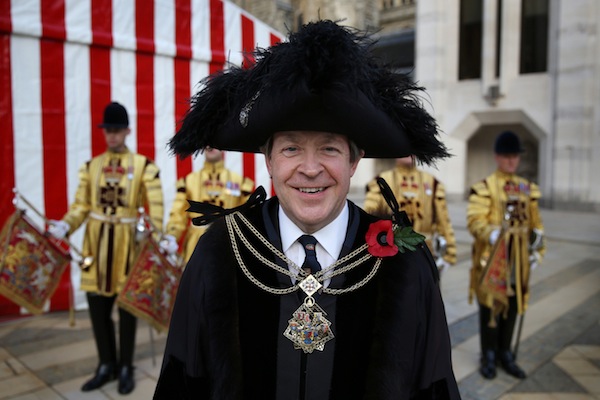The same applies at home, he says, to the elaborate formalities of the livery companies that underpin the City’s civic life. Though few participants have any connection to the original medieval crafts and trades, these ancient guilds are enjoying a revival, and those that don’t have premises of their own often use the Mansion House’s magnificent Egyptian Hall for their white-tie dinners. ‘We had the plumbers in yesterday,’ he says — referring to the Worshipful Company that traces itself to 1365 rather than, say, a couple of Poles to bleed the radiators. ‘People love it. It’s gives them pizzazz and sophistication, and it brings some good old traditional values into their lives. Don’t forget the City liveries generate £42 million a year for charities.’
 Martin Vander Weyer
Martin Vander Weyer
Is Lord Mayor Roger Gifford finally unleashing his inner Boris?

issue 06 April 2013
A short stroll from Poultry to the Mansion House offers vistas of the old and new City. The fortress of the Bank of England awaits its new Governor while the Royal Exchange earns its keep, like much of the modern Square Mile, as an upmarket nest of boutiques and eateries. The Lutyens-designed headquarters of the long-gone Midland Bank stands apparently abandoned by its oligarch owner, facing the avant-garde pink edifice that replaced the Victorian ‘Mappin & Webb Corner’. The skyline gives glimpses of the Lloyd’s Building from 1986, the Gherkin from 2003 and the ‘Walkie-Talkie’ conceived in 2007, due to be completed next year; each a monument to the boom that preceded the bust. Representing the self-confident 1750s is the Mansion House itself, last bastion of the City’s pomp and temporary home to Roger Gifford, its 685th Lord Mayor.
In such a changed and changing place, with so many stains on its name, what’s the point — I wonder as I ring the doorbell — of a fancy-dress figurehead at the apex of what is still widely seen, despite efforts towards transparency, as a quasi-masonic Corporation of sheriffs, aldermen, chamberlain and remembrancer? Indeed, what’s the point of this ceremonial ‘Lord Mayor’ at all when London at large has, in Boris Johnson, a real mayor with a million votes who not only defends financiers more robustly than any practitioner or PR man would dare, but also habitually upstages every other public figure who claims to represent the capital?
The genial Mr Gifford isn’t buying these arguments. The music-loving son of a Scottish professor turned priest, he spent a decade climbing the ladder to the mayoralty from his base as alderman for the ward of Cordwainer — a tiny patch once filled with shoemakers. On the shelf behind him a card says ‘Keep Calm I’m a Banker’, and he’s full of zest for his role as global ambassador as well as facilitator of power breakfasts and lunches in his palatial lodgings. His job, he says, is to be part of a ‘conspiracy to promote confidence’, presenting a ‘positive and jolly’ account of what the City has to offer — insurance, shipbroking, trade finance and high culture (on which his Corporation spends £80 million a year) as well as the deal-making and derivatives alchemy that’s become a bit harder to sell.
He has been banging the drum in Turkey and the Gulf, where ‘in 50 meetings I didn’t get one adverse comment’ about the decline of City ethics and the triumph of greed. ‘That’s a very UK conversation,’ he says. To the rest of the world, London is ‘an attractive place to live, work and hold money’ and Britishness in all its manifestations —even the beau ideal of the City gent, who some might say has gone the way of Mappin & Webb Corner — is loved and admired.





Comments